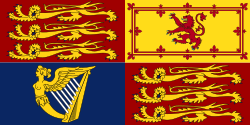
Back যুক্তরাজ্যের রাজকীয় পতাকা Bengali/Bangla Storbritanniens kongelige flag Danish Royal Standard German Estandarte del monarca británico Spanish Étendard royal du Royaume-Uni French הנס המלכותי של הממלכה המאוחדת HE Stendardo reale britannico Italian Koninklijke standaard van het Verenigd Koninkrijk Dutch Storbritannias kongelige flagg NB Estandarte Real do Reino Unido Portuguese


The royal standards of the United Kingdom presently refer to either of two similar flags used by King Charles III in his capacity as sovereign of the United Kingdom, the Crown dependencies, and the British Overseas Territories. Two versions of the flag exist, one for use within Scotland and the other for use elsewhere.
Although almost universally called a standard, such flags when used in the United Kingdom are banners of arms, as they comprise the shield of the royal arms. From the 1960s until her death in 2022, Queen Elizabeth II had several personal flags designed for her use as sovereign of certain Commonwealth realms. These heraldic flags are similar to those of the British "Royal Standard" in being banners of the nation's arms but feature a device found in the Queen's general personal flag (a blue disc containing a wreath of gold roses encircling a crowned letter 'E').
The Royal Standard of the United Kingdom is flown when the Monarch is in residence in one of the royal palaces and on his car, ship, or aeroplane. It may be flown on any building, official or private, during a visit by the Monarch, if the owner or proprietor so requests. It famously replaces the Union Flag over the Palace of Westminster when the Monarch visits during the State Opening of Parliament. The Royal Standard was flown aboard the royal yacht when it was in service, and Queen Elizabeth II was on board. The only church that may fly a Royal Standard, even without the presence of the sovereign, is Westminster Abbey, a Royal Peculiar.[2]
| List of UK flags |
|---|
 |
When Queen Elizabeth II visited the United States in 1991, she was provided with a Cadillac limousine that flew both her standard and the Stars and Stripes, an acknowledgement of the "special relationship" that exists between the two nations.[3][4][5]
The Royal Standard is flown at royal residences only when the sovereign is present. If the Union Flag flies above Buckingham Palace, Windsor Castle or Sandringham House, it signals that the King is not in residence. In 1934, King George V permitted his subjects in Scotland to display the ancient Royal Standard of Scotland as part of his silver jubilee. Today, it flies above Holyrood Palace and Balmoral Castle when the Monarch is not in residence.[1]
When the Monarch attends Parliament at the Palace of Westminster, the Royal Standard flies from Victoria Tower.[6]
Unlike the Union Flag, the Royal Standard should never be flown at half-mast, even after the demise of the Crown, as there is always a sovereign on the throne.[2] It flew at half-mast for several hours from the death of Edward VII until George V discovered the error.[7]
Controversy arose regarding the lack of a flag at half-mast over Buckingham Palace following the death of Diana, Princess of Wales, in 1997. The Queen was then in summer residence at Balmoral; and according to established custom, no flag was displayed over Buckingham Palace, as the monarch was not present. The Queen proposed a compromise whereby the Union Flag would be flown at half-mast on the day of Diana's funeral.[8] The Union Flag was also flown at half-mast over Buckingham Palace as a mark of respect on the first anniversary of the death of Diana, Princess of Wales, on Bank Holiday, Monday, 31 August 1998.[9] Since then, the Union Flag has flown regularly in the monarch's absence and has been lowered to half-mast to mark several occasions such as the death of Queen Elizabeth The Queen Mother,[10] the September 11 attacks, the 7 July 2005 London bombings[11] and the death of Elizabeth II.
- ^ a b "Rules for hoisting flags on buildings of the Scottish Government" (PDF). gov.scot. Archived from the original (PDF) on 3 February 2018. Retrieved 10 April 2016.
- ^ a b "Royal Standard". The Royal Household. Retrieved 27 December 2013.
- ^ "Outbound State Visits Since 1952" (PDF). The Royal Household. Retrieved 27 July 2020.
- ^ deWitt, Karen (17 May 1991). "Queen's Address to Congress Celebrates Mutual Respect". The New York Times. p. A10. Retrieved 27 July 2020.
- ^ Shelley, John (14 May 1991). "Queen Elizabeth II makes a state visit to the United States of America, Visiting Marshall Heights, Washington DC suburb, 14th May 1991". Getty Images. Retrieved 28 July 2023.
- ^ "The Victoria Tower". Parliament.UK. Retrieved 14 May 2019.
- ^ Windsor, Edward, Duke of (1951). A King's Story: The memoirs of the Duke of Windsor. New York: Putnam. p. 72.
{{cite book}}: CS1 maint: multiple names: authors list (link) - ^ "Blair Defends Royal Family Against Criticism". BBC News. 4 September 1997. Retrieved 27 December 2013.
- ^ "Flags at half mast for Diana". BBC News. 23 July 1998. Retrieved 17 March 2018.
- ^ "Crowds Grieve for Queen Mother". BBC News. Retrieved 27 December 2013.
- ^ "London bombings toll rises to 37". BBC News. Retrieved 27 December 2013.